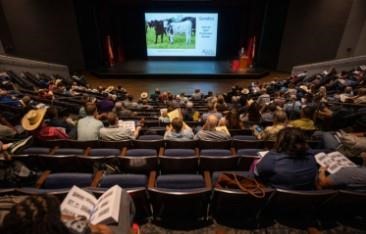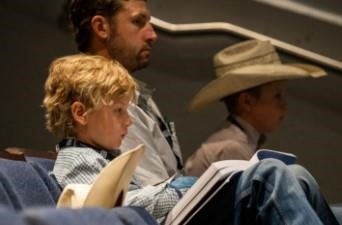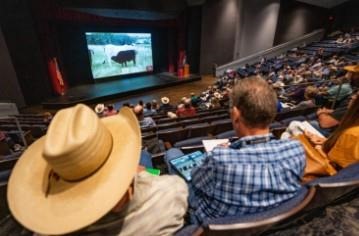By Kay Ledbetter
The 68th annual Texas A&M Beef Cattle Short Course, BCSC, wrapped up after more than 80 speakers addressed the “meat and potatoes” of ranching necessary to help ranchers survive the current drought.

Texas A&M Beef Cattle Short Course brought participants from across the state, nation and world to hear expert advice on surviving in the ranching business.
The Texas A&M AgriLife Extension Service and the Texas A&M College of Agriculture and Life Sciences Department of Animal Science hosted the event.
Jason Cleere, Ph.D., conference coordinator and AgriLife Extension beef cattle specialist in the Department of Animal Science, said more than 1,900 people settled into the Bryan-College Station area and another 175 online for the three-day event, most from Texas, but as many as 20 other states and 13 countries were represented.
“Our focus this year was the drought and how producers could mitigate the consequences of the drought,” Cleere said.
Providing ranchers with research-based education
“While weather and outside economic forces consistently impact the cattle industry, there are some things that never change, and one of those is the cattleman’s ethos of stewardship,” Rick Avery, director of AgriLife Extension, told the crowd during the general session. “You have learned to adapt and are willing to learn new things. That’s evident by your attendance today.”
Avery said participants would find valuable educational experiences at the annual event that are needed to better understand the challenges on the horizon, including the latest technologies, management practices and research. But he reminded them that AgriLife Extension is in place across the state to help them when they return to their ranches.
AgriLife Extension maintains 250 county offices and is represented in all 254 Texas counties. This network of agents and specialists extends the research-based knowledge and provides vital education for ranchers striving to get through this tough year.

Ranching advice for the current and future generations was shared at the annual Texas A&M Beef Cattle Short Course.
“During this ongoing drought, we have 160 agents and specialists who work directly in all phases of beef cattle production,” Avery said. “Their commitment to extending research discoveries is essential to helping the Texas cattle industry to be profitable and sustainable, not just for this generation, but for generations to come.”
Cyclical, drought-driven markets
Kristin Ritchie, a research analyst at New Frontier Capital Markets in Austin and a Department of Animal Science former student, said in her market outlook that ranchers shouldn’t expect things to turn around for a while, based on the cyclical nature of the cattle industry.
The drought plaguing the U.S. started about two years ago, Ritchie said, and could extend into next year.
“Cattle were being fed hay in July … that’s very expensive,” she said. “All hay prices are at record highs and are expected to average even higher over the next year. Given the current drought, it is also expensive to feed cattle grain.”
Cattle producers are selling their cows and replacement heifers, liquidating the herd, and “when we will start expanding the herd again is the unknown,” Ritchie said. “We are really liquidating and already exceeding previous years. It could be another two to three years before we start expanding again.”
So, how should producers manage moving forward?
“Control whatever you can – not the weather or China or Russia — but the land and animals,” Ritchie said. “Make sound investments, improve genetics, take advantage of specialty programs and look at the Livestock Risk Protection program.”
Advice based on experience
Ron Gill, AgriLife Extension beef cattle specialist, Bryan-College Station, said a key priority for cattle producers trying to survive the drought is to go ahead and sell their cattle if they need to so they will have enough to get back into production when the weather changes.

Managing animals and resources during drought were a key part of the message at the annual Texas A&M Beef Cattle Short Course.
“Producers need to determine what they can do to manage their natural resources now so they can come back in with the good genetics and good cattle and be profitable again later,” Gill said. “If you graze your grass too short now, it will not be able to recover when the rain comes. You need to look at optimum, not maximum, when considering the management of your natural resources.”
He said producers may need to feed cattle another nine to 12 months before this drought ends and recover begins.
“If you have a good grazing program, it will get you further through a drought, but it won’t get you through it,” Gill said. “Sell off what you need to manage what is left. Make sure you have a strategy in place to allow you to make the tough decisions.”
Some key points made by a panel of ranchers Gill moderated were:
- First, understand the economics of all decisions.
- Always manage for the next drought.
- Stay understocked, as much as 50% during this time of drought.
- Rotating pastures and giving them plenty of rest will play the biggest role in letting the grass come back when the weather pattern changes.
- Introduced grasses can give native pastures a rest.
- Utilize fencing and water distribution to manage efficient and effective grazing of pastures.
- As a business, determine what it costs to keep cows through the drought and what it would cost to replace them when it is over.
- They are just cows. You can always buy more. Just don’t feed your retirement income to the cows.
Source : tamu.edu